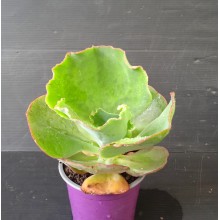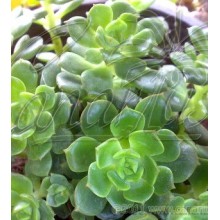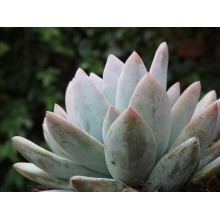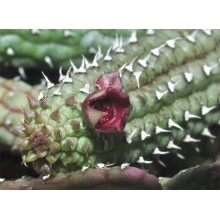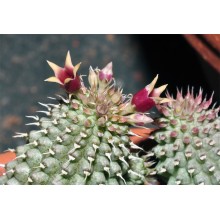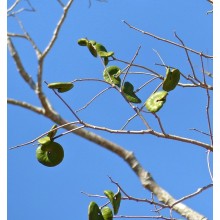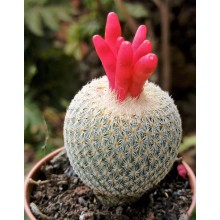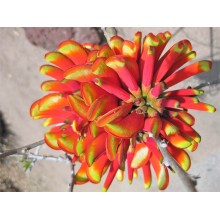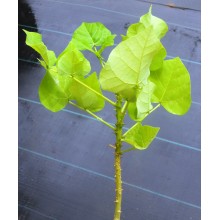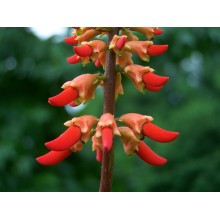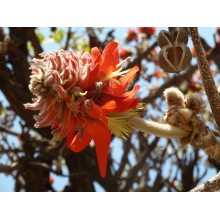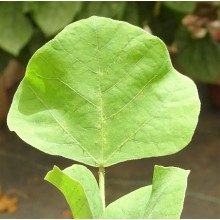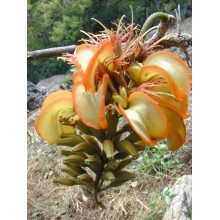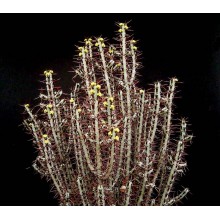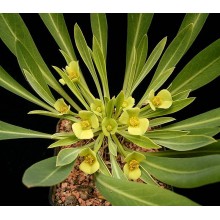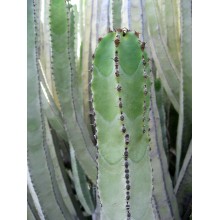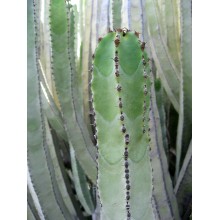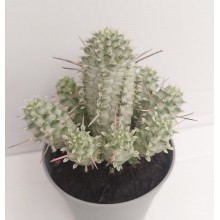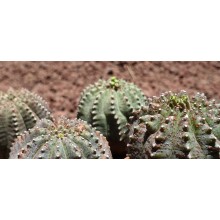Succulente Ci sono 628 prodotti.

I deserti del mondo e le zone secche ospitano le piante più interessanti. Canarius offre una selezione crescente di piante succulente di massima qualità, perché sono coltivate all'aperto, in pieno sole delle Isole Canarie.
I succulente o "piante grasse" sono specie di ritenzione di acqua, adattate alle condizioni di asciutto. Loro accumulano succum (succo, acqua) nelle loro foglie, steli o radici, e spesso mostrano un aspetto robusto e carnoso.
Sotto-categorie
-
Agave
Agave è un genere di piante grasse provenienti dall'America. Alcune specie crescono in zone fredde e possono sopportare un forte gelo, mentre altri vivono in climi tropicali. Alcuni sono piccoli nani e alcuni sono giganti, fino a 2 o 3 m di larghezza.
Le agavi resistenti al freddo possono creare un effetto esotico nel vostro giardino. Le specie agave fanno bella compagna di palme o cactus. Le agavi variegate sono incredibilmente ricercati dai collezionisti. Il nostro negozio web offre una selezione in continua evoluzione delle specie. Spediamo piante a radice nuda, se non diversamente specificato.
-
Aloe, Gasteria & Haworthia
Aloe, Gasteria e Haworthia sono tre generi correlate, comprese centinaia di piante succulente. Sono tutti facilmente coltivate in vaso. Alcuni si adattano a bassi livelli di luce di condizioni interne e possono essere coltivate come piante da appartamento.
- Aloe è un genere di circa 400 specie, originarie di Africa, Arabia e Madagascar. I aloe piccoli o nani stanno diventando particolarmente popolare in climi più freddi in quanto possono essere presi in casa durante i mesi più duri.
- Gasteria comprende circa 80 specie endemiche in Sud Africa, conosciuti per le loro foglie spettacolari che sono lucide, screziati e ruvidi. Fioriscono in primavera-estate con lunghe punte di piccoli fiori arancioni. Alcune specie sono talmente variabile che offriamo cloni particolari di località specifiche.
- Haworthia è un genere endemico in Sud Africa con circa 70 specie e un certo numero di sottospecie locali, varietà e forme. Le foglie sono spesso banded, punteggiati, punteggiato, o semi-trasparente e mostrano ampie variazioni.
-
Crassule
Questa è una nuova e crescente sezione di specie della famiglia Crassulaceae. Ci sono circa 1.400 specie in 33 generi et la loro distribuzione è in tutto il mondo, ma si presentano più nell'emisfero Nord e Sud Africa, in particolare in ambienti asciutti. Qui si possono acquistare piante sani, indurito dal sole, coltivati nelle isole Canarie e spediti a casa tua.
-
Mesembriantemi
Questo gruppo di piante del deserto è chiamato Mesembriantemi perché appartengono a una famiglia botanica precedentemente denominata Mesembryanthemaceae. Ci sono quasi 2.000 specie, che si trovano principalmente in Africa del sud, con adattamenti estremi agli habitat secco. Alcuni sono chiamati "pietre vive", perché sembrano come ciottoli. Molti sono facili da coltivare e il loro bisogno principale è pieno sole. Alcuni sono difficili perché crescono nelle aree veramente estreme.
Il nostro Web Shop offriamo piante sane coltivate al sole, con foglie compatte e colorate. Alcune piante sono venduti come talee, e altri come piante radicate, di almeno due anni. -
Sansevieria
Recentemente assegnato alla famiglia Asparagaceae, il genere Sansevieria conta circa 70 specie, quasi tutti nativi in Africa, Arabia e Madagascar. Erbe perenni adatti per gli habitat secchi con foglie rigide, succulente, la loro lunghezza varia da pochi centimetri a 2 metri. Sansevieria trifasciata e le sue numerose cultivar sono tra le piante d'appartamento più apprezzati, popolarmente chiamata la lingua di suocera. Una pianta ben coltivata di solito produce un picco di molti fiori bianchi, riccamente profumati e poi bacche arancioni. Anche le specie più rare sono resistenti ad abbandono, a condizione di tenerli dal gelo in inverno e sole cocente in estate.
-
Hoya
Le Hoyas sono rampicanti, dai fiori esotici e spesso vistosi. Provengono dalle foreste pluviali in Asia e Oceania. La maggior parte delle specie vive bene a mezz' ombra e si adatanno a vivere in casa come piante da appartamento. Sono ideali per cesti e tralicci. Tollerano un paio di settimane di siccità, ma sono sensibili al gelo e freddo. Molte hoya i sono facili da far crescere e fiorire, mentre alcune sono difficili e rare.
-
Asclepiadaceae
Le Asclepiade, o Asclepiadoideae, sono una sottofamiglia delle Apocynaceae, che annoverano circa 2900 specie diverse. Tra queste si trovano molti fusti privi di foglie ma anche erbe perenni, arbsuti, liane e, raramente, alberi. Producono fiori molto belli, dato il complesso sistema di impollinazione. Molte specie producono un odore insolito, spesso associato a quello di una carogna, la cui funzione è quella di attrarre le mosche che poi andranno a impollinare i fiori. -
Caudiciformi
Queste piante, dette anche pachicauli, sono tipiche delle zone aride. Producono un tronco insolitamente grosso e sproporzionato, detto caudice (a volte anche tubero), spesso con ramificazioni. Il caudice può essere anche nascosto sottoterra, ma nella maggior parte dei casi ha sviluppo verso l'alto, dando luogo ad alberi dalla forma spettacolare. I caudiciformi più grandi sono i baobab. -
Altre succulente
Qui troverete tutte quelle specie di piante del deserto che non sono inclusi nella propria categoria. Metteremo qui tutte le piante provenienti da famiglie inusuali, diversi da Agavi, Aloe, Crassulaceae, Sansevieria, Mesembriantemi, Epiphytic cacti, etc.
-
Echeveria x 'Victor'
Echeveria x 'Victor'
! - Three unrooted cuttings. Old Echeveria hybrid, formerly called Echeveria x Setorum. It is a small compact plant forming deep green rosettes, with branching inflorescences of orange flowers. Ideal for pots.
10,50 € -
Echidnopsis urceolata x planiflora hybrid
Echidnopsis urceolata x planiflora hybrid
New! We offer a rooted, branched plant.
10,50 € -
Edithcolea grandis
Edithcolea grandis
Stout, branched seedling. Edithcolea is monotypic genus from tropical Africa, with weird, beautiful flowers. It has a gained a reputation as a difficult plant, because it is very susceptible to rot in combination with low temperatures.
42,50 € -
Enterolobium contortisiliquum
Enterolobium contortisiliquum
Very nice ornamental shade tree, highly appreciated for its ubrella shaped crown and the unusual black-brown round fruits
54,30 € -
Epitelantha micromeris
Epitelantha micromeris
Very ornamental small cactus from the SW USA and Mexico, coated with white unharmful spines. It blooms in late winter with pale pink flowers that are soon followed by some very attractive frutis, which are dark pink, glossy and last form months!
10,80 € -
Erythrina acanthocarpa
Erythrina acanthocarpa
It has a gained a reputation as a difficult plant, because it is very susceptible to rot in combination with low temperatures.
86,80 € -
Erythrina caffra
Erythrina caffra
1-2 year old seedling. This "Dwarf Coral Tree" is native to Natal, in South Africa. It is a densely branched deciduous shrub, with scarlet flowers on black flower stalks, standing above the foliage during a long time. It is suited to mediterranean climates and takes light frosts.
32,50 € -
Erythrina humeana
Erythrina humeana
Dwarf Coral Tree is native to Natal, in South Africa. It is a densely branched deciduous shrub, with scarlet flowers on black flower stalks, standing above the foliage during a long time. It is suited to mediterranean climates and takes light frosts.
38,80 € -
Erythrina latissima
Erythrina latissima
Small tree from dry South Africa with unusually thick branches and unsually wide trifoliate leaves. These are gorgeous, velvety, with a few spines. It is very ornamental. It starts its life with a caudex and can stay in a pot for eons, keeping a nice caudex with very short shoots. Inforescences show the fabulous classic erythrina-red colour and flowers...
38,50 € -
Erythrina melanacantha
Erythrina melanacantha
Tree 4-20 m tall, with corky bark and hooked spines on the branches. The flowers have the beautiful red so typical of the genus Erythrina.
58,30 € -
Erythrina sandwicensis
Erythrina sandwicensis
Wili-wili, or Erythrina sandwicensis is endemic to the dry side of the Hawaiian Islands. It is almost a succulent plant, as it often grows on dry lava rock, with a thick trunk. Flower colours range through different hues and each specimen is different: they can be Green to Yellow to different types of Orange.
38,00 € -
Euphorbia aeruginosa
Euphorbia aeruginosa
Very ornamental, compact shrubby cactiform Euphorbia from South Africa,with blue-grey-green stems and rusty red spines. Bright yellow flowers are nice too.
11,20 € -
Euphorbia bupleurifolia
Euphorbia bupleurifolia
Small gem from South Africa, growing with a short and "fat" caudex-stem, often unbranched, resembling a dry pinecone.
13,60 € -
Euphorbia canariensis
Euphorbia canariensis
Endemic succulent from Canary Islands, widespread on the drier and rocky areas of the archipelago.
32,50 € -
Euphorbia canariensis - Large
Euphorbia canariensis - Large
Endemic succulent from Canary Islands, widespread on the drier and rocky areas of the archipelago.
84,00 € -
Euphorbia obesa
Euphorbia obesa
This is an old classic for succulent collectors, but still everybody needs a new one. The obese euphorbia is native to the Cape Province of South Africa. It is very elegant and very resistant to neglect. They live for many years at a very slow pace.
11,20 €
Al momento ci sono pochi prodotti in questa categoria Succulente

























